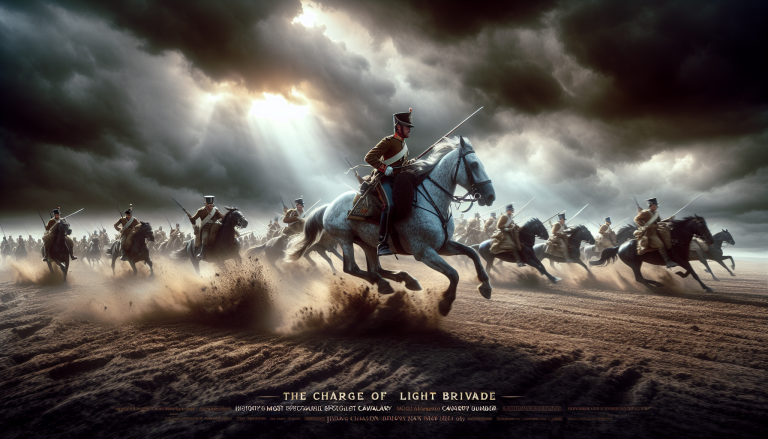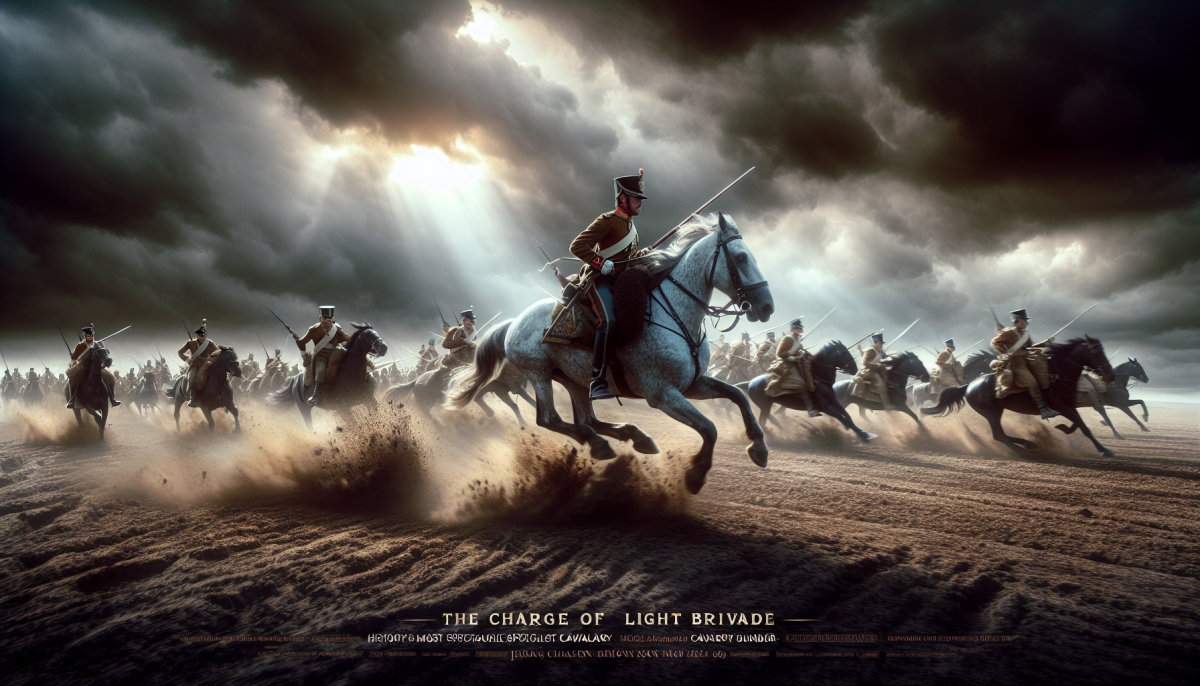The Charge That Charged Off Into History: The Cavalry’s Dead Horse Tango at Balaclava
Ah, the Crimean War, that rollicking 1850s melee where empires clumsily jousted over the bleak wastelands of the Black Sea. But if you’re looking for an event so famously futile and absurd that it redefines “beating a dead horse,” look no further than the 1854 Charge of the Light Brigade, a military blunder so spectacular that even the history textbooks pause to guffaw.
Picture this: a British cavalry unit, noble gents astride their steeds, galloping full-throttle straight into a Russian cauldron of artillery shells and musket fire. The order, miscommunicated through a tangled web of confusion, led (pun absolutely intended) the Light Brigade to attack the wrong enemy position. The result? About six hundred horsemen charging headfirst into an artillery hellscape that would have made even the bravest warhorse reconsider its life choices.
This event is the classic embodiment of futility. The troops not only charged into certain death, but their very mission was a misunderstanding. It was less a tactical maneuver and more a tragicomedy played out by men and ponies alike. So where does the phrase “beating a dead horse” enter this scene? Well, ask any historian or cavalry enthusiast: trying to rewrite this episode as a strategic success is the definition of futile.
The Blunder Written in Brass and Bones
Lord Cardigan, commander of the brigade, may have had the best intentions tucked beneath his ironclad helmet, but intentions didn’t stop cannonballs from pulverizing his men. The order to “attack the enemy’s guns” became, thanks to several layers of garbled communication, “attack the enemy’s guns… that aren’t really the enemy’s guns, and fire will be incoming from three sides.”
Reports from the front describe soldiers who, although courageous to a fault, were essentially asked to beat a technical dead horse: a battle already lost on the map. The phrase fits because commanders on the ground were hurling manpower into a cause that was strategically pointless—a futile exercise bordering on absurd. The men charged with unyielding bravery, only to discover the objective itself was a mirage concocted by a fog of confusion.
Tennyson must have known the phrase before it was coined because his famous poem, “The Charge of the Light Brigade,” immortalized the event with solemnity:
*“Theirs not to reason why,
Theirs but to do and die…”*
But if you replace “reason why” with “understand that the target was never theirs,” the poem reads like a medieval version of “Why are we doing this again?” The men were marching to their deaths in a manner that was as heroic as it was futile, a perfect real-life metaphor for beating an already deceased equine.
Beating a Dead Horse: Where It All Went Wrong

To examine the “beating a dead horse” metaphor—in this case, literally mounted cavalry galloping into annihilation—consider the chain of communication that led to disaster:
– The commanding general, Lord Raglan, issues an order based on incomplete reconnaissance: “Advance on and prevent the enemy removing captured guns.”
– The order passes through Captain Nolan, whose explanation to Lord Lucan (commander of the cavalry) was ambiguous at best.
– Lord Lucan misunderstood the target, assuming a direct frontal attack was required.
– Lord Cardigan, prompted by his commander, leads the Light Brigade directly into the mouth of the Russian artillery.
The military version of a game of “telephone,” this chain showcases the futility of blindly following orders when context is missing. Yet, the men obeyed, charging as if the dead horse of a plan might magically beat back into life.
From The Horse’s Mouth: Satire and Cartoons Join the Fray
Satirists and cartoonists wasted no time immortalizing this disaster with gallows humor. Victorian cartoons featured horses with comically spelling-out expressions of disbelief, clutching their heads in hay-filled hands, muttering “Why won’t they just stop beating me?” One particularly popular cartoon showed a skeletal horse galloping with a banner reading, “Charge! Charge! And charge again… because no one remembers to call it off.”
Newspapers turned the phrase “beating a dead horse” into a blunt epitaph for the Charge of the Light Brigade. Editorials lambasted the military hierarchy for their stubbornness and incompetence, noting that the tragedy was not bravery alone but “a magnificent display of futile perseverance—beating a dead horse, in every sense.”
A satirical poem of the era poked fun at the cavalry’s predicament:
*“Onward we ride with a plan quite absurd,
Into the guns where no man is heard.
Our steeds gallop fearless through volley and smoke—
Futile it seems, yet we beat the dead horse’s yoke.”*
Even modern military analysts use the event as a textbook study in “What not to do when the enemy’s artillery is basically a fireworks show for them and a funeral procession for us.”
Futility in the Face of Glory: The Human Element
The phrase “beating a dead horse” doesn’t just capture military blunders on paper; it encompasses the stubbornness and pride of human nature. The Light Brigade’s charge reflects a collective refusal to stop a futile effort, even when the signs scream “retreat!” or “pick a better hill!”
Was it cowardice? Far from it. Men followed orders, clinging to the belief that valor was its own reward. But in the grand, absurd theatre of war, valor can sometimes feel like trying to revive a horse long since expired—in other words: futile.
Those horses, of course, had no say in any of this. They pranced into history unwilling chorus members, hoofbeats fading into the tragic score of a futile campaign desperate to find meaning in mechanisms of bureaucratic inertia.
The Dead Horse Gets a Legacy
Post-battle, the Light Brigade became legend—not as a triumphant cavalry but as the epitome of gallant futility. The charge is memorized by schoolchildren, wittily lamented by historians, and endlessly cited whenever someone doggedly persisting in a hopeless task calls for a dose of ironic reality.
“Beating a dead horse” isn’t just an idiom; it’s a solemn warning shimmering in the echoes of cannon fire and hooves, reminding us that some efforts, no matter how spirited, remain hilariously and heartbreakingly useless.
If there’s a silver lining, it’s that this historical blunder continues to inspire art, literature, and the occasional dad joke about persistence, pride, and the rare occasions when beating a dead horse isn’t just metaphorical—it’s a horde of cavalry charging into the Russian guns, because someone, somewhere, missed an inkling of common sense.
In the grand theatre of history, the Charge of the Light Brigade is the ultimate “futile” encore. A reminder that bravado without clarity is just a dead horse waiting for a comic reprise. And that, dear readers, is how you take a blunder and gallop it straight into the annals of irony.
